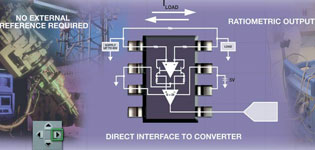Current sense amplifier guarantees low temperature drift
25 July 2007
Analogue, Mixed Signal, LSI

Analog Devices claims that its AD8210 bidirectional current sense amplifier is the industry’s most integrated, flexible and accurate. The device features ±8 μV/°C maximum offset drift and 20 ppm/°C maximum gain drift guaranteed across the entire -40°C to +125°C temperature range, combined with 500 kHz bandwidth and 20 V/V gain.
The device improves the user's ability to meet their error budget and to control more precisely a wide range of loads in communications, industrial, and medical applications.
Two other bidirectional monitors - the AD8205 (gain of 50 V/V) and the AD8206 (gain of 20 V/V) - offer 50 kHz operation and excellent performance over temperature. All three amplifiers feature an innovative ratiometric output offset architecture that inherently improves the accuracy of the user's ADC and therefore the system. With a typical 5 V single-supply, each device can be configured for both bidirectional and unidirectional current sensing. Output accuracy is maintained throughout the input voltage range through the use of a proprietary thin film precision network.
Further reading:
Ultra-low power MEMS accelerometer
Altron Arrow
Analogue, Mixed Signal, LSI
Analog Devices’ ADXL366 is an ultra-low power, 3-axis MEMS accelerometer that consumes only 0,96 µA at a 100 Hz output data rate and 191 nA when in motion-triggered wake-up mode.
Read more...
BT Audio 4 Click board
Dizzy Enterprises
Analogue, Mixed Signal, LSI
The BT Audio 4 Click board from MIKROE provides high-quality wireless audio streaming and data comms over Bluetooth.
Read more...
Precision MEMS IMU modules
Altron Arrow
Analogue, Mixed Signal, LSI
The ADIS16575/ADIS16576/ADIS16577 from Analog Devices are precision, MEMS IMUs that includes a triaxial gyroscope and a triaxial accelerometer.
Read more...
MEMS with embedded AI processing
Altron Arrow
Analogue, Mixed Signal, LSI
STMicroelectronics has announced an inertial measurement unit that combines sensors tuned for activity tracking and high-g impact measurement into a single, space-saving package.
Read more...
High-performance IMU
RS South Africa
Analogue, Mixed Signal, LSI
TDK Corporation has announced availability of the new InvenSense SmartMotion ICM-536xx family of high-performance 6-axis IMUs.
Read more...
High-temperature closed-loop MEMS accelerometer
RS South Africa
Analogue, Mixed Signal, LSI
This sensor from TDK is a high-temperature MEMS accelerometer with ±14 g input range and a digital interface for measurement while drilling applications.
Read more...
Dual accelerometers on the same die
Altron Arrow
Analogue, Mixed Signal, LSI
The LSM6DSV320X is the first mainstream inertial sensor to house a gyroscope alongside two accelerometers, one capable of sensing up to ±16 g and one sensing up to a staggering ±320 g.
Read more...
Dual-range IMU with edge processing
EBV Electrolink
Analogue, Mixed Signal, LSI
ST’s innovative LSM6DSV80X combines two accelerometer structures for 16 g and 80 g full-scale sensing, a gyroscope up 4000 dps, and embedded intelligence in a single component.
Read more...
High-reliability isolation amplifiers
EBV Electrolink
Analogue, Mixed Signal, LSI
The VIA series of isolation amplifiers from Vishay are designed to deliver exceptional thermal stability and precise measurement capabilities.
Read more...
Mibbo QT2C Series signal isolators
Conical Technologies
Analogue, Mixed Signal, LSI
The Mibbo QT2C Series isolators support a rich combination of input and output signals, working with either current loops or voltage levels.
Read more...


